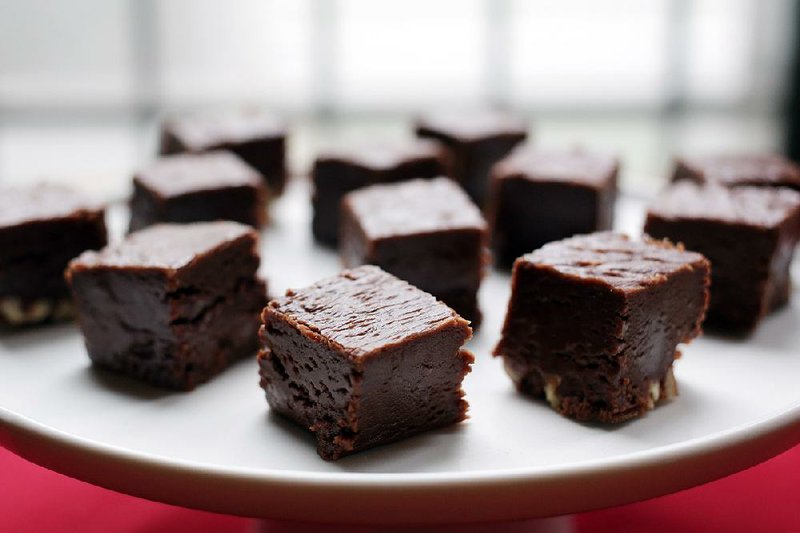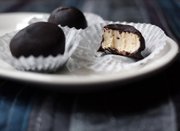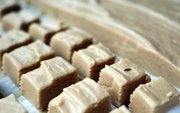Fudge.
My hefty, well-worn Webster's New World College Dictionary defines fudge as the following:
(from the German futsch -- which, by the way, translates as went down the drain; went to hell; is gone and not coming back; was lost; disappeared)
Noun
1) empty, foolish talk; nonsense
2) a soft candy made of butter, milk, sugar and chocolate or other flavoring, etc.
3) a short piece of last-minute news or other matter, inserted directly in the plate of a newspaper page
Transitive verb fudged, fudging
to make or put together dishonestly or carelessly; fake
Intransitive verb
1) to refuse to commit oneself or give a direct answer; hedge
2) to be dishonest; cheat
I can think of no other food word with such varied and conflicting meanings. How can something made of pure sugar, butter and cream that tastes so good, also mean fake and dishonest?
The origin of the confection is unknown, although many food historians agree what we know as fudge was likely the result of a botched batch of caramels. Some accounts credit a candy maker in Michigan while others cite students at women's colleges including Smith, Vassar and Wellesley. Both origin stories have fudge being created in 1886.
However, it should be noted that fudge is quite similar to fondant, a confection with roots in France, originating in the 1870s. The main difference is fudge includes dairy and fondant is strictly sugar and flavoring.
Traditional fudge takes effort, serious effort. The sought-after smooth, creamy texture of traditional fudge is the result of precise timing and physical labor. The sugar mixture is heated to 237 to 240 degrees and then cooled to 110 before beating to create the proper texture and consistency. According to Anita Chu in Field Guide to Candy: How to Identify and Make Virtually Every Candy Imaginable, fudge's texture comes from the formation of small sugar crystals after the mixture cools to 110 degrees. If it is stirred too soon -- when it is warmer than 110 degrees -- the crystals will be large and make the fudge grainy. To help achieve the ideal texture many fudge recipes include corn syrup or liquid glucose, as glucose doesn't crystallize as easily as sucrose (granulated/white sugar).
A candy thermometer is essential when fudge is made from a traditional recipe. If you cook the mixture too hot, you're likely to end up with a crumbly, grainy sweet brick. Not hot enough and the mixture won't set and you'll have a sweet, sticky glue.
Modern "no fail" fudge recipes, on the other hand, let you (pardon the pun) fudge a little as they rely on marshmallows or sweetened condensed milk for structure and creaminess.
Salted Fudge With Cinnamon
3 cups granulated sugar
1 1/2 cups (3 sticks) butter
2/3 cup evaporated milk
12 ounces semisweet or dark chocolate chips
7 ounces marshmallow creme
1/2 teaspoon ground cinnamon
Coarse salt
Line a 9-by-13-inch baking pan with parchment paper, leaving overhang on two opposite sides; set aside.
In a heavy saucepan, combine the sugar, butter and evaporated milk over medium heat, stirring occasionally until butter melts. Increase heat to high and bring to a full, rolling boil. Boil, stirring constantly, for 3 minutes. Reduce heat to low and stir in the chocolate chips, marshmallow creme and cinnamon, stirring until mixture is completely smooth. Pour into the prepared pan, smoothing top. Sprinkle with coarse salt. Let cool until set. Cut into squares.
Recipe adapted from The Forest Feast Gatherings: Simple Vegetarian Menus for Hosting Friends and Family by Erin Gleeson
Chocolate Mint Fudge
3 cups granulated sugar
1 cup butter
2/3 cup half-and-half
9 ounces mint-filled chocolate chips
3 ounces semisweet or dark chocolate chips
7 ounces marshmallow creme
Line a 9-by-13-inch baking pan with parchment paper, leaving overhang on two opposite sides; set aside.
In a heavy saucepan, combine the sugar, butter and half-and-half over medium heat, stirring occasionally until butter melts. Increase heat to high and bring to a full, rolling boil. Boil, stirring constantly, for 3 minutes. Reduce heat to low and stir in the chocolate chips and marshmallow creme, stirring until mixture is completely smooth. Pour into the prepared pan, smoothing top. Let cool until set. Cut into squares.
Opera fudge, sometimes called opera cream, differs from traditional fudge, but it is a truly delicious treat. The fudge is cooked, cooled and beaten or whipped until creamy and frequently dipped in chocolate. The bonbons are most common in Pennsylvania, Ohio and Illinois, and are especially associated with the Lebanon, Pa., and Cincinnati areas, according to Foodtimeline.org.
Opera Fudge
2 cups granulated sugar
1 cup heavy cream
3 tablespoons butter, cut into cubes, plus more for coating
2 tablespoons light corn syrup
1/8 teaspoon salt
2 teaspoons vanilla extract
1/2 pound unsweetened chocolate
1/4 ounce food paraffin
Coat a rimmed baking sheet with butter; set aside.
In a heavy saucepan, combine sugar and cream. Cook, stirring, over medium-low heat until sugar dissolves and mixture comes to a boil. As soon as the mixture boils, stop stirring. Add butter, corn syrup and salt and cook, without stirring, until mixture reaches 240 degrees on a candy thermometer.
Pour mixture onto prepared baking sheet in an even layer. Let cool 2 hours, or until mixture is dry to the touch. Transfer mixture to a bowl (or the bowl of a stand mixer) and stir in vanilla. Continue stirring until mixture lightens in color, loses its shine, and is no longer sticky, 15 to 45 minutes. When properly beaten, the mixture will have a texture similar to buttercream frosting. Roll mixture into small balls, about 1 inch in diameter. Place on a parchment-paper-lined baking sheet and refrigerate until firm and cold, about 10 minutes.
In the top part of a double boiler set over barely simmering water, melt chocolate and food paraffin, stirring until smooth and well combined. Reshape fudge balls if necessary and dip fudge balls in chocolate, returning dipped balls to the parchment-lined baking sheet. Refrigerate until fudge is chilled and chocolate has set, about 30 minutes. Bring to room temperature before serving.
Variation: Orange Opera Fudge, replace 1 teaspoon of the vanilla extract with 1 teaspoon orange extract.
Recipe adapted from Field Guide to Candy by Anita Chu and Rose Richard via Martha Stewart
This fudge sets softer than most, but with its delectable honey taste, even a failed batch is delicious.
Honey Fudge
1 3/4 cups granulated sugar
14 ounces sweetened condensed milk
1/3 cup water
Pinch salt
3 tablespoons dark, flavorful honey, divided use
1 teaspoon vanilla extract
31/3 tablespoons cold, unsalted butter, cut into cubes
Lightly coat an 8-inch square pan with butter or oil or line with parchment paper.
In a heavy saucepan, combine sugar, condensed milk and water. Heat mixture gently, stirring until sugar dissolves. Stir in the salt and 2 tablespoons of the honey. Bring to a boil and cook without stirring until mixture reaches 240 degrees on a candy thermometer.
Remove from heat, add the vanilla extract, butter and remaining tablespoon of honey. Beat vigorously with a wooden spoon until mixture thickens and loses its shine. Immediately spread mixture into the prepared pan and smooth top with the back of a spoon, or press smooth using a sheet of parchment paper. Cool completely before cutting into squares.
Makes about 64 (1-inch) pieces.
Recipe adapted from Honey: A Selection of More Than 80 Delicious Savory & Sweet Recipes by Hattie Ellis
Triple Chocolate Fudge
1 cup margarine or butter
4 cups sugar
1 cup milk
25 large marshmallows
12 ounces chocolate chips
2 ounces unsweetened chocolate
13 ounces milk chocolate bar such as Hershey's
1 to 2 cups chopped nuts, optional (see note)
Line a 9-by-13-inch pan with parchment paper or generously coat with butter.
In a heavy saucepan, combine the butter, sugar and milk. Cook, stirring, until butter melts and sugar dissolves. Stir in marshmallows and cook, stirring until smooth. Bring mixture to a boil, then add all of the chocolate. Remove pan from heat and stir until smooth. Stir in nuts, if using. Pour into the prepared pan and let cool completely before cutting into squares.
Note: Because not everybody likes nuts in their fudge, we like to make this recipe half with nuts and half without nuts. Instead of stirring the nuts into the fudge mixture, scatter them on bottom of one half of the baking dish and then pour in the fudge.
Recipe from Joe Riddle's sister Ann Blaylock
Peanut Butter Fudge
3 cups granulated sugar
1/2 cup butter
1 (5-ounce) can evaporated milk
1 2/3 cups creamy peanut butter
1 (7-ounce) jar marshmallow creme
1 teaspoon vanilla extract
Line a rimmed baking sheet or 9-by-13-inch baking dish with parchment paper or generously grease with butter.
In a heavy saucepan, combine the sugar, butter and milk over medium heat. Cook, stirring constantly, until mixture combines to a boil. Reduce heat and simmer, stirring constantly, for 5 minutes.
Remove from heat. Stir in peanut butter, then stir in the marshmallow creme and vanilla extract. Stir until no white streaks remain. Pour mixture into the prepared pan, smoothing into an even layer. Let cool completely before cutting into squares.
Makes about 115 (1-inch) pieces.
Recipe adapted from Jif
Food on 12/14/2016




